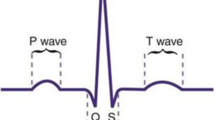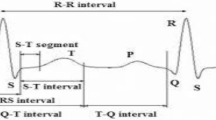Abstract
The report of World Health Organization (WHO) specifies that the diagnosis and treatment of cardiovascular diseases are challenging tasks. To study the electrical conductivity of the heart, Electrocardiogram (ECG) which is an inexpensive diagnostic tool, is used. Classification is the most well-known topic for arrhythmia detection related to cardiovascular disease. Many algorithms have been evolved for the classification of heartbeat arrhythmia in the previous few decades using the CAD system. In this paper, we have developed a new deep CNN (11-layer) model for automatically classifying ECG heartbeats into five different groups according to the ANSI-AAMI standard (1998) without using feature extraction and selection techniques. The experiment is performed on publicly available Physionet MIT-BIH database and evaluated results are then compared with the existing works mentioned in the literature. To handle the problem of minority classes as well as the class imbalance problem, the database has been oversampled artificially using SMOTE technique. The augmented ECG database was employed for training the model while the testing was performed on the unseen dataset. On evaluation of the results from the experiment, we found that the proposed CNN model performed better in comparison to the experiments mentioned in other papers in terms of accuracy, sensitivity, and specificity. abstract environment.
Access this chapter
Tax calculation will be finalised at checkout
Purchases are for personal use only
Similar content being viewed by others
References
Mehra R (2007) Global public health problem of sudden cardiac death. J Electrocardiol 40(6):S118–S122
World Health Organization (2017) Noncommunicable diseases: progress monitor 2017
Hadhoud MM, Eladawy MI, Farag A (2006) Computer aided diagnosis of cardiac arrhythmias. In: 2006 international conference on computer engineering and systems. IEEE
Singh S et al (2018) Classification of ECG arrhythmia using recurrent neural networks. Procedia Comput Sci 132:1290–1297
De Chazal P, O’Dwyer M, Reilly RB (2004) Automatic classification of heartbeats using ECG morphology and heartbeat interval features. IEEE Trans Biomed Eng 51(7):1196–1206
Alonso-Atienza F et al (2014) Detection of life-threatening arrhythmias using feature selection and support vector machines. IEEE Trans Biomed Eng 61(3):832–840
Khadra L, Al-Fahoum AS, Al-Nashash H (1997) Detection of life-threatening cardiac arrhythmias using the wavelet transformation. Med Biol Eng Comput 35(6):626–632
Sörnmo L, Laguna P (2005) Bioelectrical signal processing in cardiac and neurological applications, vol 8. Academic Press
Melillo P et al (2015) Wearable technology and ECG processing for fall risk assessment, prevention and detection. In: 2015 37th Annual International Conference of the IEEE engineering in medicine and biology society (EMBC). IEEE
Jain S et al (2017) QRS detection using adaptive filters: a comparative study. ISA Trans 66:362–375
Gacek A, Pedrycz E (eds) (2011) ECG signal processing, classification and interpretation: a comprehensive framework of computational intelligence. Springer Science & Business Media
Das MK, Ari S (2014) ECG beats classification using mixture of features.Int Sch Res Not 2014
Engin M (2004) ECG beat classification using neuro-fuzzy network. Pattern Recogn Lett 25(15):1715–1722
Lannoy G et al (2010) Feature relevance assessment in automatic inter-patient heart beat classification. Biosignals
Mar T et al (2011) Optimization of ECG classification by means of feature selection. IEEE Trans Biomed Eng 58(8):2168–2177
De Chazal P, Reilly RB (2006) A patient-adapting heartbeat classifier using ECG morphology and heartbeat interval features. IEEE Trans Biomed Eng 53(12):2535–2543
Ye C, Vijaya Kumar BVK, Coimbra MT (2012) Heartbeat classification using morphological and dynamic features of ECG signals. IEEE Trans Biomed Eng 59(10):2930–2941
Kutlu Y, Kuntalp D (2011) A multi-stage automatic arrhythmia recognition and classification system. Comput Biol Med 41(1):37–45
Llamedo M, Martínez JP (2011) Heartbeat classification using feature selection driven by database generalization criteria. IEEE Trans Biomed Eng 58(3):616–625
Das MK, Ghosh DK, Ari S (2013) Electrocardiogram (ECG) signal classification using s-transform, genetic algorithm and neural network. In: 2013 IEEE 1st international conference on condition assessment techniques in electrical systems (CATCON). IEEE
Shinde AA, Kanjalkar P (2011) The comparison of different transform based methods for ECG data compression. In: 2011 international conference on signal processing, communication, computing and networking technologies (ICSCCN). IEEE
Martis RJ, Acharya UR, Min LC (2013) ECG beat classification using PCA, LDA, ICA and discrete wavelet transform. Biomed Signal Process Control 8(5):437–448
Zhang L, Peng H, Yu C (2010) An approach for ECG classification based on wavelet feature extraction and decision tree. In: 2010 international conference on wireless communications and signal processing (WCSP). IEEE
Tang X, Shu L (2014) Classification of electrocardiogram signals with RS and quantum neural networks. International Journal of Multimedia and Ubiquitous Engineering 9(2):363–372
Rai HM, Trivedi A, Shukla S (2013) ECG signal processing for abnormalities detection using multi-resolution wavelet transform and Artificial Neural Network classifier. Measurement 46(9):3238–3246D
Alickovic E, Subasi A (2016) Medical decision support system for diagnosis of heart arrhythmia using DWT and random forests classifier. Journal of medical systems 40(4):108
Elhaj FA et al (2017) Hybrid classification of Bayesian and extreme learning machine for heartbeat classification of arrhythmia detection. In: 2017 6th ICT International student project conference (ICT-ISPC). IEEE
Khalaf AF, Owis MI, Yassine IDA (2015) A novel technique for cardiac arrhythmia classification using spectral correlation and support vector machines. Expert Systems with Applications 42(21):8361–8368
Rajesh KNVPS, Dhuli R (2018) Classification of imbalanced ECG beats using re-sampling techniques and AdaBoost ensemble classifier. Biomed Signal Process Control 41:242–254
Lu W, Hou H, Chu J (2018) Feature fusion for imbalanced ECG data analysis. Biomedical Signal Processing and Control 41:152–160
Roopa CK, Harish BS (2017) A survey on various machine learning approaches for ECG analysis. Int J Comput Appl 163(9)
Litjens G et al (2017) A survey on deep learning in medical image analysis. Med Image Anal 42:60–88
Acharya UR et al (2017) Deep convolutional neural network for the automated detection and diagnosis of seizure using EEG signals. Comput Biol Med
Wang Q et al (2017) A novel ensemble method for imbalanced data learning: bagging of extrapolation-SMOTE SVM. Comput Intell Neurosci
Goldberger AL et al (2000) PhysioBank, PhysioToolkit, and PhysioNet: components of a new research resource for complex physiologic signals. Circulation 101(23):e215–e220
Moody GB, Mark RG (2001) The impact of the MIT-BIH arrhythmia database. IEEE Engineering in Medicine and Biology Magazine 20(3):45–50
Luz EJDS et al (2016) ECG-based heartbeat classification for arrhythmia detection: a survey. Comput Methods Programs Biomed 127:144–164
Wikipedia contributors. “Feature scaling.” Wikipedia, The Free Encyclopedia. Wikipedia, The Free Encyclopedia, 24 Jun. 2018. https://en.wikipedia.org/w/index.php?title=Feature_scaling&oldid=847274325
Chen S et al (2017) Heartbeat classification using projected and dynamic features of ECG signal. Biomed Signal Process Control 31:165–173
Chen Y-S (2016) An empirical study of a hybrid imbalanced-class DT-RST classification procedure to elucidate therapeutic effects in uremia patients. Medical & biological engineering & computing 54(6):983–1001
Radivojac P et al (2004) Classification and knowledge discovery in protein databases. J Biomed Inform 37(4):224–239
Zheng Z, Xiaoyun W, Srihari R (2004) Feature selection for text categorization on imbalanced data. ACM Sigkdd Explorations Newsletter 6(1):80–89
Prati RC, Batista GEAPA, Monard MC (2008) A study with class imbalance and random sampling for a decision tree learning system. In: IFIP international conference on artificial intelligence in theory and practice. Springer, Boston, MA
Chawla NV et al (2002) SMOTE: synthetic minority over-sampling technique. J Artif Intell Res 16:321–357
Karpathy A (2016) Cs231n convolutional neural networks for visual recognition. Neural networks 1
Zebik M et al (2017) Convolutional neural networks for time series classification. In: International conference on artificial intelligence and soft computing. Springer, Cham
Zheng Y et al (2014) Time series classification using multi-channels deep convolutional neural networks. In: International conference on web-age information management. Springer, Cham
Krizhevsky A, Sutskever I, Hinton GE (2012) Imagenet classification with deep convolutional neural networks. In: Advances in neural information processing systems
Bani-Hasan, AM, El-Hefnawi MF, Kadah MY (2011) Model-based parameter estimation applied on electrocardiogram signal. J Comput Biol Bioinform Res 3(2):25–28
Martis RJ et al (2013) Cardiac decision making using higher order spectra. Biomed Signal Process Control 8(2):193–203
De Chazal P (2013) A switching feature extraction system for ECG heartbeat classification. In: 2013 computing in cardiology conference (CinC). IEEE
Tang X, Shu L (2014) Classification of electrocardiogram signals with RS and quantum neural networks. Int J Multimed Ubiquitous Eng 9(2):363–372
Lin C-C, Yang C-M (2014) Heartbeat classification using normalized RR intervals and morphological features. Math Probl Eng
Zubair M, Kim J, Yoon C (2016) An automated ECG beat classification system using convolutional neural networks. In: 2016 6th international conference on IT convergence and security (ICITCS). IEEE
Li T, Zhou M (2016) ECG classification using wavelet packet entropy and random forests. Entropy 18(8):285
Shadmand S, Mashoufi B (2016) A new personalized ECG signal classification algorithm using block-based neural network and particle swarm optimization. Biomed Signal Process Control 25:12–23
Acharya UR et al (2017) A deep convolutional neural network model to classify heartbeats. Comput Biol Med 89:389–396
Author information
Authors and Affiliations
Corresponding author
Editor information
Editors and Affiliations
Rights and permissions
Copyright information
© 2020 Springer Nature Singapore Pte Ltd.
About this chapter
Cite this chapter
Pandey, S.K., Janghel, R.R., Varma, K. (2020). Classification of ECG Heartbeat Using Deep Convolutional Neural Network. In: Rout, J., Rout, M., Das, H. (eds) Machine Learning for Intelligent Decision Science. Algorithms for Intelligent Systems. Springer, Singapore. https://doi.org/10.1007/978-981-15-3689-2_2
Download citation
DOI: https://doi.org/10.1007/978-981-15-3689-2_2
Published:
Publisher Name: Springer, Singapore
Print ISBN: 978-981-15-3688-5
Online ISBN: 978-981-15-3689-2
eBook Packages: Intelligent Technologies and RoboticsIntelligent Technologies and Robotics (R0)




